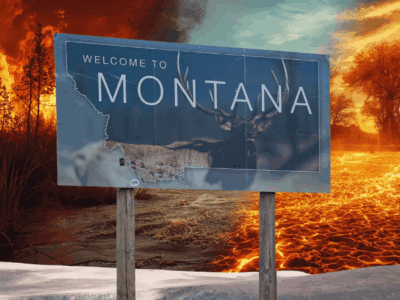Briefly noted: four recent federal appellate decisions
Here are links to and brief descriptions of four interesting recent decisions from federal appellate courts:
-

A disputed "road" in Kane County. Photo: KSL.com Wilderness Society v. Kane County, 10th Cir., en banc, 1/11/2011. This decision is the latest in a long-running dispute over the extent to which Kane County in southern Utah can authorize the use of off-road vehicles on federal lands. A Civil War-era law known as R.S. 2477 generally granted the right of way for establishment of public roads in accordance with state law on federal lands not reserved for public uses. R.S. 2477 was repealed by the Federal Land Policy Management Act in 1976, but FLPMA grandfathers pre-existing R.S. 2477 rights. The extent of those rights has been hotly disputed because they potentially provide a weapon for local governments which object to federal restrictions on the use of motorized vehicles on wilderness and park lands. Kane County has been anxious to use that weapon in the Grand Staircase-Escalante National Monument. In 2003, it demanded that BLM remove signs closing roads in the Monument over which the County claimed R.S. 2477 rights. When BLM refused, County employees removed the signs, replaced them with signs indicating the disputed roads were open to ORV use, and passed an ordinance purporting to open them for such use. The United States didn’t go to court, but The Wilderness Society and Southern Utah Wilderness Alliance did. They sought a declaration that Kane County’s actions were unlawful, and an injunction prohibiting future action to open roads on federal land. The environmental plaintiffs won in the District Court, and on appeal before a 3-judge panel. But the Tenth Circuit agreed to rehear the decision en banc, and in this decision the full court reversed, holding that the environmental plaintiffs lacked standing. The majority did not reach the question of constitutional standing. Even assuming the plaintiffs met the requirements of Article III, it held that they lacked prudential standing. According to the majority, plaintiffs sought to vindicate the property rights of the United States, a task better left to the U.S. itself. Three concurring judges would have reached the same result on grounds that the dispute was largely moot and, to the extent a live conflict remained, plaintiffs’ injuries would not be redressed by a favorable decision. Two judges strongly dissented, arguing that plaintiffs were simply trying to assert a conventional Supremacy Clause argument that federal land management plans preempted the County’s actions and that the majority’s decision would “have long-term deleterious effects on the use and management of federal public lands.” Meanwhile, Kane County is litigating its R.S. 2477 title to 15 roads in a quiet title action against the U.S. Last fall the U.S. stipulated that the County has valid rights over 27 miles of the Skutumpah Road, described by the Deseret News as “a back road . . . within boundaries of the Grand Staircase-Escalante National Monument.
- Precon Development Corp. v. U.S. Army Corps of Engineers, 4th Cir., 1/25/2011. This is the latest Court of Appeal decision to interpret and apply the Supreme Court’s decision Rapanos decision on the scope of federal Clean Water Act jurisdiction. (Sean blogged here some time ago about the challenges of interpreting Rapanos. The New York Times today begins a series of stories about the muddled mess that currently is wetlands regulation.) Justice Kennedy’s concurring decision in that case, which the lower courts agree is decisive, requires a showing that there be a “significant nexus” between wetlands over which federal jurisdiction is asserted and traditionally navigable waters. Applying its post-Rapanos guidance, the Corps of Engineers determined that wetlands at the site of a proposed development in southern Virginia were subject to federal jurisdiction. The developer sued, and the district court upheld the Corps’ finding of jurisdiction. The Fourth Circuit reversed, finding that the record was not adequate to support the Corps’ conclusion. The court refused to give Chevron deference to the Corps’ guidance, which was not adopted through notice-and-comment rulemaking. Nonetheless, recognizing the Corps’ expertise, it held that it should “give deference to [the Corps’] interpretation and application of Justice Kennedy’s test where appropriate.” Applying that deference, the court ruled that the Corps had provided the “bare minimum of persuasive reasoning” to support its aggregation of the wetlands at issue with a much larger area of surrounding wetlands for purposes of the significant nexus evaluation, but had not provided enough information to support its determination that the wetlands had a significant nexus with the river several miles away. The nexus was established by the Corps’ description of the various ecosystem services provided by the wetlands, but proving significance would required some discussion of the “comparative relationship between the wetlands at issue, their adjacent tributary, and traditional navigable waters.” Because that discussion was lacking, the court directed the lower court to remand the decision to the Corps for further consideration.
- Wilderness Society v. U.S. Forest Service, 9th Cir., en banc, 1/14/2011. In this brief opinion, the Ninth Circuit overruled the “federal defendant” rule it had applied to limit intervention as of right in NEPA cases. NEPA imposes duties only on the federal government, so NEPA suits must always name a federal actor as the defendant. Private entities affected by the challenged federal decision may seek to intervene on the government’s side in order to defend the agency’s NEPA actions. Typically, those would-be intervenors are industry or extractive interests, because a NEPA challenge necessarily alleges that the agency did not do enough to understand the environmental implications of its actions. Since about 1990, the Ninth Circuit has not permitted intervention as of right as a defendant in the merits of a NEPA action. This case was taken en banc to consider overruling that rule, and the 11-judge court did so unanimously. The opinion reports that 37 amici, from all sides of the political spectrum, urged overruling, none apparently supported the federal defendant rule. The decision eliminates “NEPA exceptionalism.” From now on, requests for intervention as of right in NEPA cases will be judged by the same standards that apply to all other cases.
- Association of Irritated Residents v. EPA, 9th Cir., 2/2/2011. In this Clean Air Act case, environmental groups challenged EPA’s approval of revisions to California’s State Implementation Plan for meeting the National Ambient Air Quality Standard for ozone. The court held that EPA has a continuing duty to evaluate SIPs. When California submitted revisions with new modeling that undermined the assumptions on which other parts of the SIP were based, EPA had a duty to take a fresh look at the SIP as a whole to determine whether it would achieve attainment. The court also held that California’s plan was required to include transportation control measures. The plain language of the statute, the court said, requires transportation control measures to offset the effects of increasing Vehicle Miles Traveled, even if cleaner cars meant that there would be no net increase in mobile source emissions.
Reader Comments
One Reply to “Briefly noted: four recent federal appellate decisions”
Comments are closed.







“A Civil War-era law known as R.S. 2477”
I’d just like to point out the implied bias in a statement like this, and encourage care in its deployment. The fact that this law was passed in the 1860s alone does not make it anachronistic or unimportant. The “____-era law” phrase can be useful when explaining a true anachronism such as the Colonial Ordinance governing beach access in Maine and Massachusetts, but shouldn’t be used as a punchline without explanation, lest people start talking about “That Revolutionary War-era document, the Constitution…”